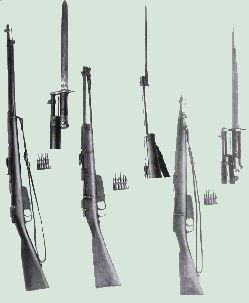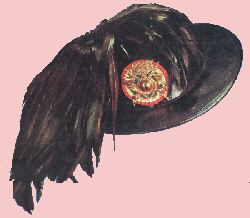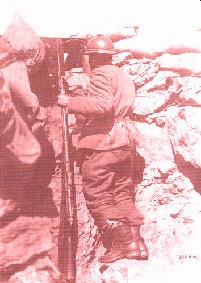GLISENTI MODEL 1910 SEMIAUTOMATIC PISTOL (9MM.):
Called "The Poor Man's Lugar" because of its appearance, poor quality material and mediocre performance in action. Designed in 1906 for a 7.65 mm shell, a larger caliber round was later deemed necessary, so it was re chambered for a 9 mm bullet. It was found, subsequently that the new configuration could not use the 9mm. Parabellum bullet, so a less powerful 9mm round was developed for the weapon, thus negating the effect the larger caliber. It had a 7 round clip which was inserted in the pistol butt.
.
|

|
|

|
BERETTA BREVETTA 1915 SEMIAUTOMATIC PISTOL (9MM.):
The forerunner of the Beretta semiautomatic pistols, the famous gun manufacturer started making military hand guns in 1915, the year Italy declared war. Designed in two versions, 7.65 and 9 mm, it was sturdy enough to use much more powerful loads than Italy was manufacturing. Although much better made and more economical to manufacture, it still did not completely replace the Glisenti model 1910 during the war. Weighing 880 gms. (just under 2 lbs.), the pistol had an 8 round clip.
.
|
|
VILLAR PEROSA-REVELLI 9MM MACHINE PISTOL, MODEL 1915:
The first portable machine gun used in World War I, this weapon consisted of two nickel and steel barreled pistols connected together, and mounted on a biped or directly on a shield. The breech had two openings, the top one to insert a 25 round semilunar [banana] clip and the lower one to eject the spent cartridges. Firing the Italian 9 mm Glisenti pistol round, it was underpowered by the standards of the other nation's 9 mm rounds. Other weaknesses included the high rate of fire at 300 rounds a minute per barrel and a short effective range. With 25 round clips it had to be recharged 12 times a minute at full fire. Because its effective range was only about 100 meters [it had a theoretical range of 800 M.] making reloading extremely risky for the gunner.
.
|

|
|

|
MANNLICHER-CARCANO MODEL 1891 OF 6.5 MM. CALIBER RIFLE
: The standard Italian rifle of the Great War was adopted in 1891. It was fed with a 6-round clip. The clip was a Mannlicher design and the breech block assembly was designed by an Italian gunsmith named Carcano. While it is looked down upon by some devotees of the "finer" rifles, it was a rugged weapon that didn't foul up easily and withstood hard treatment. Its smaller cartridges [6.5mm vs. 7.6mm] meant a soldier could carry more rounds and its clip held 6 rounds vs. 5 per clip for almost all rifles of the other belligerents. It's length [140 cm, 160 cm with the bayonet] which can be noted in the photo at the top of this article was designed for an obsolete method of warfare, allowing an infantryman to fend off the lance or saber of a mounted cavalryman. Since it proved to be clumsy in the tight confines of the trenches, a carbine version called the 'moschetto' adapted from the carbine version used by the cavalry was also given to special troops, carabinieri [MP's], officers, NCOs and Arditi [shock troops]. Both carbines fired the same cartridge the rifle did, indeed they were just shortened versions of the rifle. Both had a turned down bolt handle rather than a straight one. The cavalry version had a built in folding bayonet while the infantry adaptation had a detachable one and a longer wood stock. All three versions are displayed here.
.
|
|
THE FIAT-REVELLI MODEL 1914:
Italy's main machine gun of the war, although some Italian units were also equipped with Maxim and St. Etienne models. Designed by Revelli in 1910 and derived from an earlier model Perino, it was improved still more after it was adopted in 1914. It featured a selector which allowed it to be fired in continuous or short bursts, magazines holding 50 rounds (6.5 mm.) and 100 rounds later in the war and a water cooling system. The early version had a cone shaped, 16 cm. flash suppressor and an armored shield to protect the gunners which was rarely used in the field because of its excessive weight.
.
|

|
|

|
FIAT-REVELLI MODEL 1914.1:
The later model was improved with a stronger, sturdier cooling sleeve which was also ribbed to give it more surface area to better dissipate the heat. Both Fiats weighed 38.5 kg. (85 lbs.) with the tripod. In theory their rate of fire was 500 rounds per minute, but in fact it fired about 150-200 rounds/ minute. It was accurate to 1500 M. (about 1 mile).
.
|
|
TRENCH MORTAR (BETTICA) AND PROJECTILE:
This was a small compact trench weapon with a range of about 200-250 meters depending on the weight of the missile. The projectile was fitted over a tube whose elevation could be adjusted to fire at different angles and was fired by a lighting the fuse with a lit cigar or punk. The lit fuse took 10 seconds to detonate the missile. Shown is one of the projectiles which came in several lengths and weights: the diameters varying from 38 to 60 cm; weights from 2.5kg. (5.5 lbs.) to 4.3 kg. (9 lbs)
.
|

|
|

|
GRENADE LAUNCHER MINUCCIANI [HAND CRANKED MORTAR]:
Mounted on a wooden stand, the mechanism for this launcher consisted of a crank, flywheel, gears, and sprockets. It worked like a baseball pitching machine or tennis throwing machine. The crank was turned to build up the tension, a discus shaped bomb [see photo] was inserted in a funnel-like opening on the side, the pin holding the tension was removed, and the disc shaped missile, weighing 510 gm. [1+ lbs.] was flung up to 200 meters [650 ft.]. An internal fuse was ignited by friction when the missile was fired and was set for 8 seconds. The disk held 175 gms [6 oz] of explosives which would send off splinters 15 Meters [45-50 ft]. A skilled crew was said to be able to fire up to 30 bombs a minute. The shell was modified from a 1914 model discus shaped hand grenade.
.
|

|
INTRENCHING TOOLS:
A twin leather holster is shown holding a Model 9 bayonet and a small combination pick and mattock. This was not a general issue piece of equipment because of its expense to produce, but was provided only to front line troops close to enemy lines.
.
|

|
|

|
GAS MASKS:
Until after the Battle of Caporetto, when the English box gas mask was adopted, the Italian gas masks evolved from single purpose (monovolente) to multipurpose (polivolente) filter masks. A. The filter for the first model(top left) was made of a thick wad of gauze over 2 layers of thin cloth. At the moment of use it was necessary to activate it by saturating the cloth with a solution of hydrosulfate and carbonate of soda. It was effective only against chlorine gas. Goggles were worn separately. B. Another monovolente mask (top right), called the Ciamician-Pisci type, had a conical shape. It was made of 10 layers of gauze saturated with an alkaline solution of sodium carbonate and potassium carbonate. To keep the alkaline solution from irritating the users lips a strip of flannel protected the mouth. It, too, offered protection only against chlorine. It was a major cause of a disaster at Monte San Michele on the Carso which was abandoned when the Austrians attacked with phosgene gas. C. The first Italian polivolente mask [lower left] was patterned after the French TN model and appeared on the front in April 1916. It protected against both chlorine and phosgene gas and differed from the French model in that it had 64 layers of muslin rather than 38. It came with celluloid lens goggles that could be worn separately for tear gas protection, but which fogged up easily. D. The later polivolente mask [lower right] based on the French model M2 was called the funnel type. It consisted of a filter of 60 layers of gauze that extended over the face and cheeks completely. The goggles were incorporated into the mask and were made of celluloid. The mask was covered by a rectangular, rubberized cloth which gave protection from rain and prevented the evaporation of the reactive chemicals in the layers of gauze. It was kept in a container carried around the neck on which this message was stenciled, "WHO REMOVES HIS MASK DIES." After Caporetto when the inability of these gas masks to protect against the newer gases became disastrously clear, Italian soldiers were equipped with the far superior English gas masks
.
|
|
TELEFERICO:
The teleferico, a precursor of the ski lift, was used to transport supplies and individuals or small groups to high positions in the Alps. They also transported the wounded down to hospitals. Larger installations were motorized; a hand operated teleferico is shown here. In some cases the occupant, himself, supplied the power.
.
|

|

|

|
SKI KIT:
Shown are Alpini Francesco Quadri [on left, later killed in action] and Aldo Varenna both in snow camouflage uniforms. Quadri is wearing a one piece coverall. Varenna is wearing separate jacket and pants coverings and white leggings which were nicknamed "fasce compresse" or compress bandages. Both are wearing white gloves and white snow caps. These special kits were necessitated by the severe weather at high altitudes. Both are carrying the carbine version of the Mannlicher-Carcano rifle issued to specialized troops.
.
|
|
ALPINI HAT:
Worn by Italy's elite mountain troops with a distinctive eagle feather. At the beginning of the war the feathers were removed because they were considered too conspicuous, but were re-authorized in the late 1917. During the World War these soldiers were chosen from those who lived in the Alpine regions or in one or two of the higher mountain areas of the Apennines and were formed into close-knit units from the same local areas. Each unit had a different color pompom attached at the base of the feather. The Alpini keep their hats after they are discharged and even today veterans might be seen wearing their hats at reunions or on commemoration days.
.
|

|
|

|
BERSAGLIERI HAT:
The Bersaglieri are light fast moving infantry troops who were formed in the mid 1800s by the House of Savoy, in the old Kingdom of Sardinia before the unification of Italy. The unit was designed to travel long distances as fast as possible on foot. Their regular hat is of a somewhat clumsy design of leather and felt with a copper or brass insignia over a tricolored cockade on the front and a showy plume of rooster feathers on the side. Roosters are considered symbols of bravery and fighting ability. On front line duty, when a helmet was necessary, the plumes were worn on the helmets.
.
|
|
BERSAGLIERI FEZ:
While part of the Sardinian Army, the Bersaglieri were sent to the Crimea to fight with the French, English and Turks against the Russians, and they won a battle at Tchernaya. The Zouaves of the French forces (uniform on left) awarded them the right to wear the red fez with a blue bow. It is worn as a fatigue hat.
|

|
|

|
CARABINIERE HAT:
The Carabinieri are Italy's national police force and serve as military police for the army. When on the front line they wore the regulation helmet; behind the front they wore a green-gray cloth over their traditional, colorful, headgear called the "Lucerna". During the war the Carabinieri were called "Caproni" (after the large Italian bombing plane) by the troops because of the hat's wing-like appearance.
.
|
Contact Leo Benedetti with
suggestions corrections and additions for this article.
|






